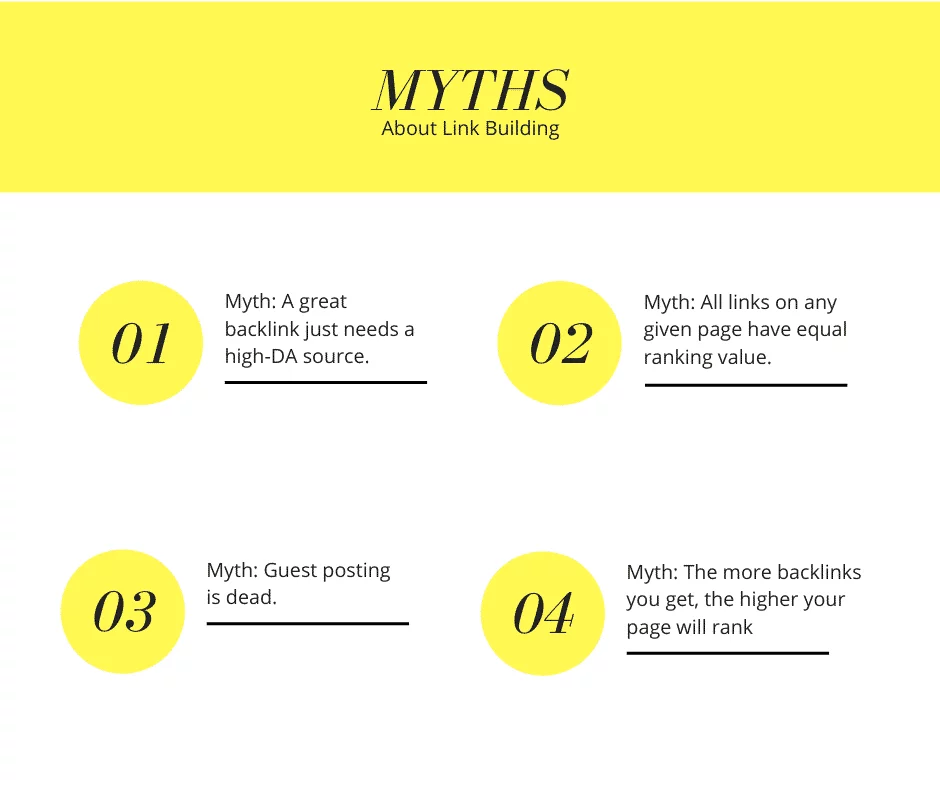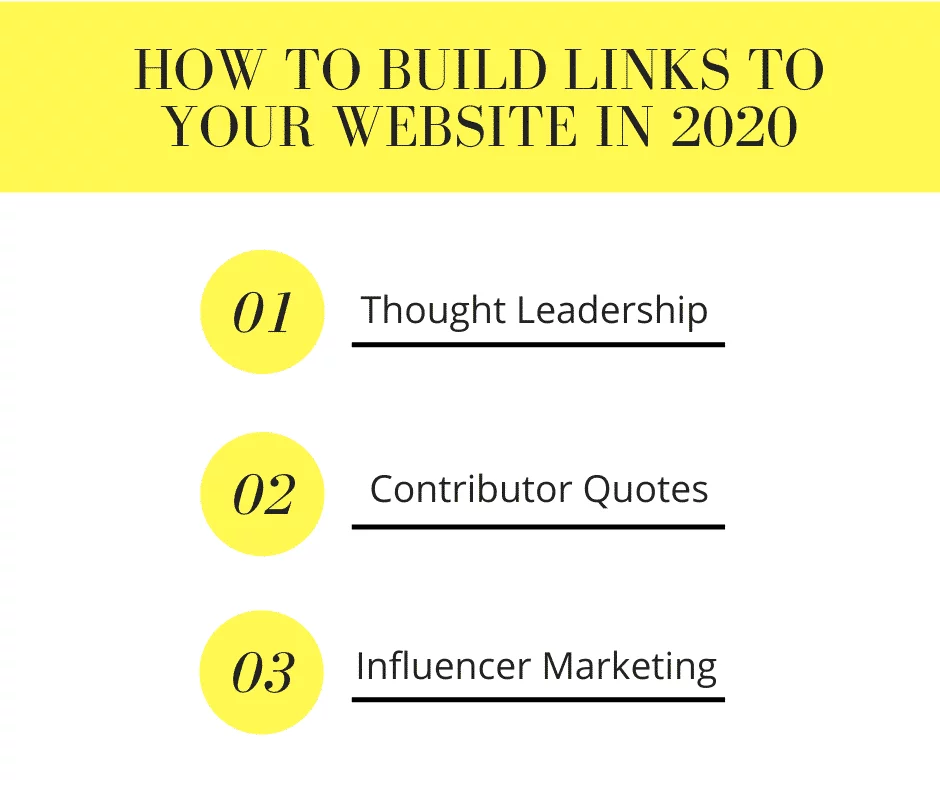“Link building is frowned upon.”
“Link building is black hat SEO.”
“Link building will not help you rank on Google.”
If you work in digital marketing, you have probably heard statements like the ones above. You might even have a few friends in the industry right at this moment who are telling you the same things. While certain types of link building are definitely bad, making a blanket statement against the whole enterprise is wrong.
Today, you are in luck, because I am about to prove the generalization false and clarify your concerns surrounding link building. I will also take it a step further and show you how to build high-quality links to your website the right way in 2020.
The myths about link building, and demystifying the process
There is so much information out there about link building and how it should not be the priority of an SEO who is trying to help clients rank higher. Here are some of the myths surrounding backlinks.
Myth #1: A Great Backlink Just Needs a High-DA Source
Sure, it is true that getting backlinks from high-authority websites can help your own site rank higher. The problem with this is that domain authority (DA) isn’t everything. You have to consider other things, as well, such as:
- Relevance: Is this website relevant to my target niche?
- Traffic: Does this website have a decent amount of frequent and unique users visiting every month?
- Inbound links: Does the website I am trying to link back from have a healthy backlink profile on its own?
Myth #2: All Links on Any Given Page Have Equal Ranking Value
Placing anchor text on a page has to be strategic. You must remember that most people don’t read past the first few paragraphs of a content page. Inserting the anchor text with the link to your target page in one of the first two paragraphs is the way to go to increase traffic to the page.
Myth #3: Guest Posting is Dead
One of the most frustrating myths I have encountered in this industry is that guest posting is dead. This is simply not true. Creating relationships with bloggers and news sites for the sake of sharing relevant content should be the rule of law amongst fellow bloggers. Doing so could earn a link back to your website, and it can do the same for the blogger. This is the most organic way of earning a link, and it works. I assure you this will help you rank higher.
At the same time, remember this: paying for a piece of content to be placed on anyone’s website for the sake of creating a backlink (AKA” buying links”) is wrong! Google penalizes websites that buy links in large volumes. The best way to leverage guest posting is to do it organically by reaching out to bloggers, person to person.
Myth #4: The More Backlinks You Get, the Higher Your Page Will Rank
I mentioned that a backlink from a website with a high domain authority could earn you a higher ranking for a particular term on a page. But, at the same time, having a bunch of irrelevant inbound links pointing toward one of your web pages can damage your site.
Now, links to and from corporate giants such as Best Buy or Target would be welcome in any case. That’s because you will find affiliate marketers always linking back to their product pages (and there are many affiliate marketers out there). But, if you are trying to rank highly, try to keep your backlinks as relevant as possible and coming from non-spammy websites.
You have to consider all the metrics mentioned above and always be mindful of the health of the website from which you are trying to get a backlink.
Building High-Quality Backlinks to Your Website
Before I dive into actually building high-quality links to your site, I would like to mention that there are many, many ways of gaining backlinks that I could not possibly cover in one post. With that said, let’s dive into how to build links to your website in 2020:
Thought Leadership
It is no mystery that if you are an expert on any given subject, and someone needs your expertise, they will come to you to benefit from your knowledge. And, believe it or not, this is what happens in the world of SEO.
Share your knowledge with people who are interested in featuring your perspective on their newly written blog post or news article. Sign up for a free service such as Help A Reporter Out (HARO). You will receive three batches of emails a day: one in the morning, the next one in the afternoon, and the last one in the evening. This gives you plenty of opportunities to share your point of view on any given subject.
Answering HARO queries can be tricky, and there are a few guidelines you should follow to get featured. Normally, the reporters ask you to answer their queries in a specific format. Answering the questions the way the reporters want gives you the best chance of getting responses back from them. This can leave them wanting to know more, and–if your quote is good enough–you will get featured in someone’s article.
Contributor Quotes
On the other hand, if you are looking to add a different perspective to a piece of content for your own blog post, you could try to reverse the HARO process.
Get quotes from industry experts by crafting surveys for them to answer, and use their responses to build your piece. Use a service such as Survey Monkey or Youtube’s Brand Lift Surveys to gather the information you are looking for.
Then, create a spreadsheet where you can organize everything you received, such as the names of the respondents, their title and company, and, of course, their answers to your survey questions. Next, write the article with their quotes included, and link their company mention to their website. Once the article is live online, reach back out to the people who provided quotes to let them know the post has been published.
This process will allow you to obtain more inbound links to your website, which will translate to more web traffic coming your way.
Influencer Marketing
This is probably the most controversial point on this list. Influencer marketing does not mean just sending products to an influencer to promote or review. It can be useful to leverage influencers for e-commerce sites, but this is not the only way influencers can help to get more links to your site.
Guest posting is still relevant here. If an influencer owns a blog and is willing to help you promote your content through guest posting, that could be another effective way of tackling backlinking in 2020.
You can create long-term relationships with those influencers by providing great content for them to post on their websites. Keep the relationships going by doing the same for influencers when and if they ever need you to help promote their content. The more you interact with the influencers in your network, the better those relationships will be. They might even know other influencers who would be willing to work with you. Keep forming those relationships! It will only help you.
Something to Keep in Mind
There is a lot to take in when it comes to building high-quality backlinks. By working through all the strategies I have suggested, you will likely encounter great successes and some failures; roadblocks and obstacles are simply part of the process. However, I can guarantee that if you persist in applying the tactics in this post, you will ultimately succeed in finding superior link-building opportunities.
My best advice to anyone reading this right now is to get really good at one strategy. Whether you are a blogger trying to rank for higher terms or a business owner looking for opportunities to promote your brand, find your niche and run with it. Try not to get distracted by all the fancy and complicated techniques out there.
If you are looking to take your company to the next level through digital marketing, LSEO’s link building strategies have helped many businesses to achieve their goals.


